
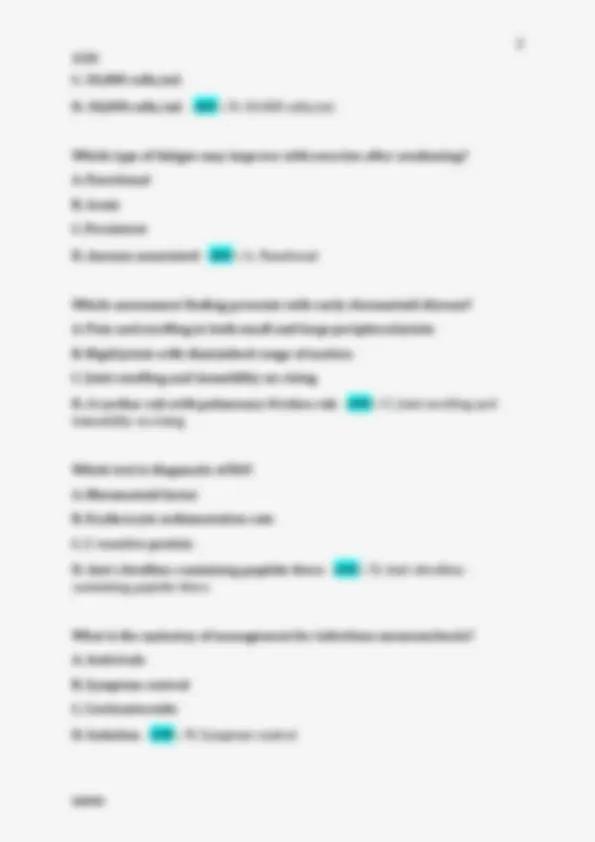
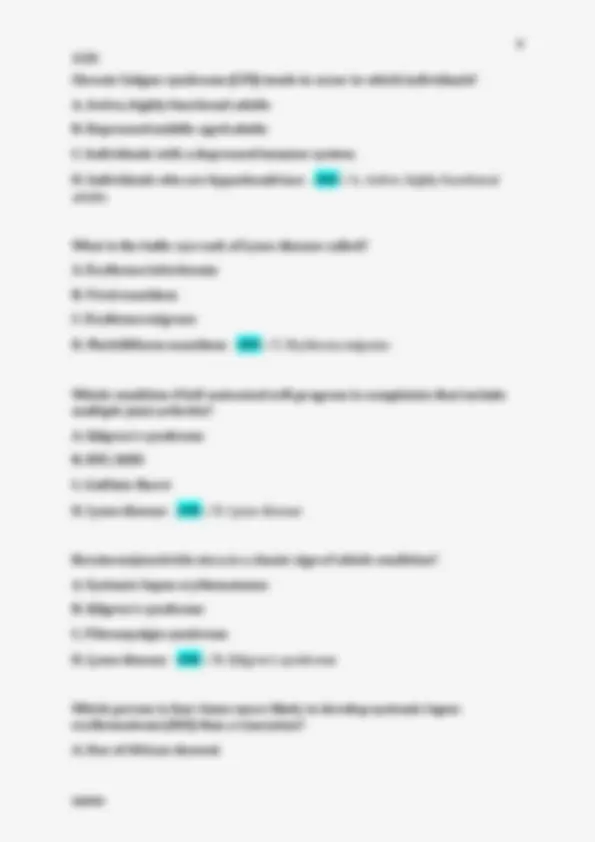
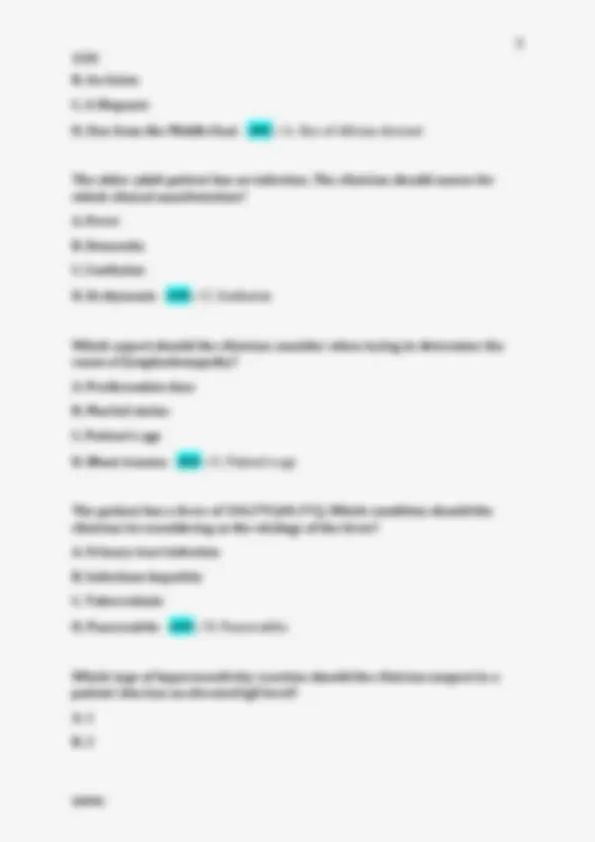
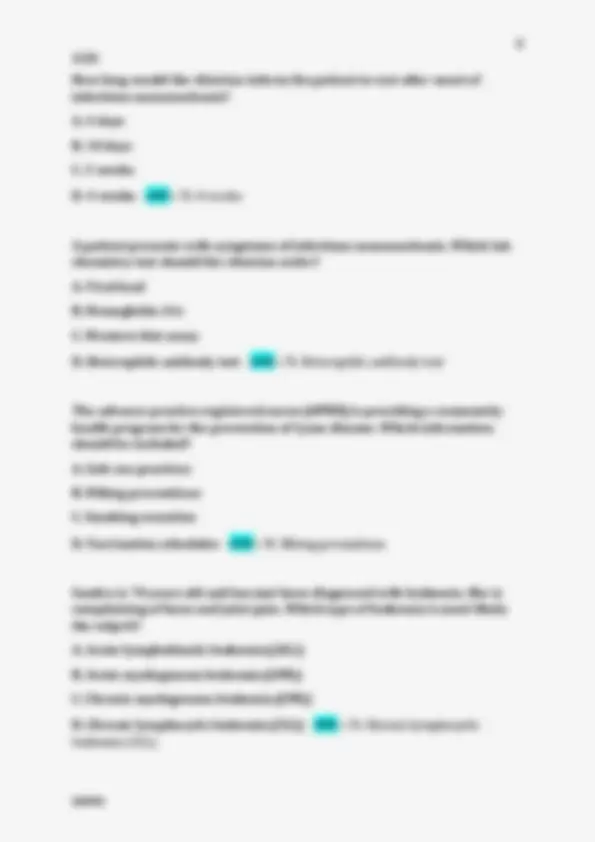
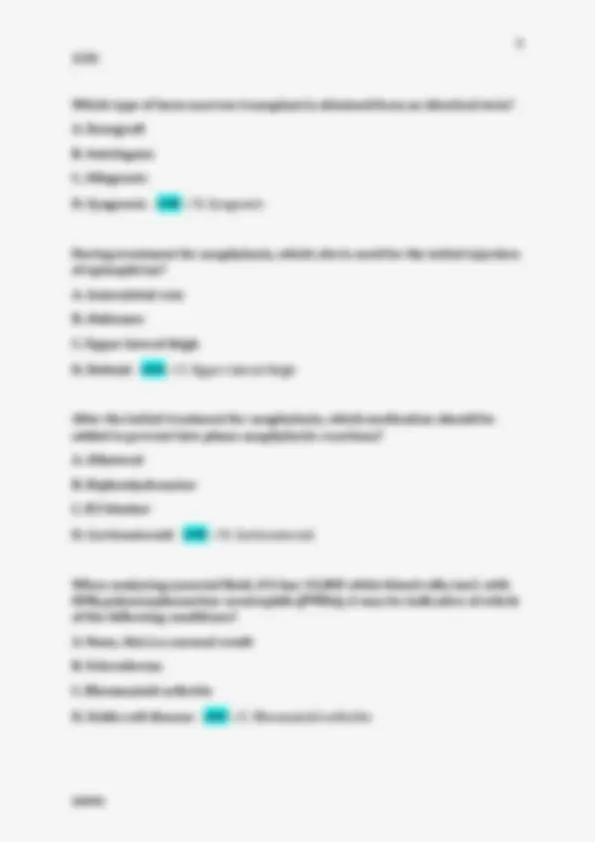
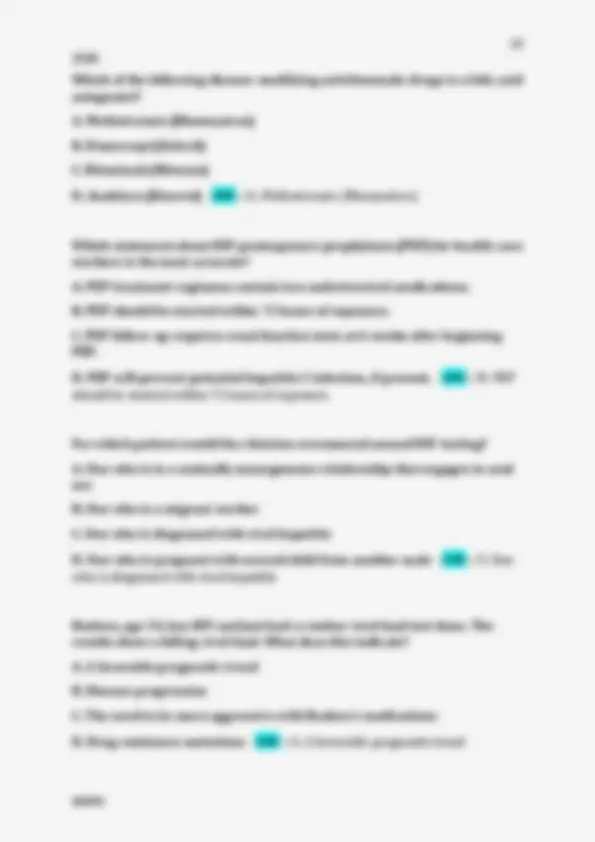



Study with the several resources on Docsity

Earn points by helping other students or get them with a premium plan


Prepare for your exams
Study with the several resources on Docsity

Earn points to download
Earn points by helping other students or get them with a premium plan
Community
Ask the community for help and clear up your study doubts
Discover the best universities in your country according to Docsity users
Free resources
Download our free guides on studying techniques, anxiety management strategies, and thesis advice from Docsity tutors
A series of multiple-choice questions and answers related to hematological and immunological problems. it covers various conditions such as lyme disease, sjögren's syndrome, hiv infection, rheumatoid arthritis, infectious mononucleosis, chronic fatigue syndrome, and leukemia. the questions test knowledge of symptoms, diagnostic tests, treatment approaches, and relevant clinical considerations for each condition. This resource is valuable for medical students and professionals seeking to review or assess their understanding of these topics.
Typology: Exams
1 / 13

This page cannot be seen from the preview
Don't miss anything!








After returning from visiting his grandchildren in Connecticut, George, age 59, complains of a flulike illness, including fever, chills, and myalgia. He reports having discovered a rash or red spot that grew in size on his right leg. Which disease should the clinician be considering? A. Rubella B. Lyme disease C. Fibromyalgia syndrome D. Shingles - ANS ✓B. Lyme disease Dryness of the eyes and mouth is typical of which condition? A. Sjögren's syndrome B. Allergic reaction C. Hypothyroidism D. Sideroblastic anemia - ANS ✓A. Sjögren's syndrome Exposure to ultraviolet (UV)-B and UV-A rays is a triggering factor for acute exacerbations of which condition? A. Rheumatoid arthritis B. Gout C. Systemic lupus erythematosus D. Sjögren's syndrome - ANS ✓C. Systemic lupus erythematosus What is the current goal of treatment for a patient with HIV infection? A. Viral suppression to undetectable levels
B. Compete eradication of the virus C. Limit contact with uninfected individuals D. Total abstinence - ANS ✓A. Viral suppression to undetectable levels Which test should the clinician use to initially screen for HIV? A. Western blot B. Enzyme-linked immunosorbent assay C. HIV-1/2 antigen/antibody combination immunoassay D. Nucleic acid amplification testing - ANS ✓C. HIV-1/2 antigen/antibody combination immunoassay Which lab test would the clinician order to monitor for a significant side effect from tenofovir disoproxil fumarate? A. Urine protein B. Allele genetic testing C. Sodium level D. Hemoglobin - ANS ✓A. Urine protein Which drug category of antiretroviral (ARV) therapy is generally effective in crossing the blood-brain barrier and may be useful in managing HIV- associated dementia? A. Nucleoside reverse transcriptase inhibitors B. Protease inhibitors C. Integrase inhibitors D. Nonnucleoside reverse transcriptase inhibitors - ANS ✓D. Nonnucleoside reverse transcriptase inhibitors Spontaneous bruising may be seen with platelet counts below what level? A. 100,000 cells/mL B. 75,000 cells/mL
Chronic fatigue syndrome (CFS) tends to occur in which individuals? A. Active, highly functional adults B. Depressed middle-aged adults C. Individuals with a depressed immune system D. Individuals who are hypochondriacs - ANS ✓A. Active, highly functional adults What is the bulls-eye rash of Lyme disease called? A. Erythema infectiosum B. Viral exanthem C. Erythema migrans D. Morbilliform exanthem - ANS ✓C. Erythema migrans Which condition if left untreated will progress to complaints that include multiple joint arthritis? A. Sjögren's syndrome B. HIV/AIDS C. Guillain-Barré D. Lyme disease - ANS ✓D. Lyme disease Keratoconjunctivitis sicca is a classic sign of which condition? A. Systemic lupus erythematosus B. Sjögren's syndrome C. Fibromyalgia syndrome D. Lyme disease - ANS ✓B. Sjögren's syndrome Which person is four times more likely to develop systemic lupus erythematosus (SLE) than a Caucasian? A. One of African descent
B. An Asian C. A Hispanic D. One from the Middle East - ANS ✓A. One of African descent The older adult patient has an infection. The clinician should assess for which clinical manifestation? A. Fever B. Dementia C. Confusion D. Ecchymosis - ANS ✓C. Confusion Which aspect should the clinician consider when trying to determine the cause of lymphadenopathy? A. Prothrombin time B. Marital status C. Patient's age D. Blunt trauma - ANS ✓C. Patient's age The patient has a fever of 104.2°F (40.1°C). Which condition should the clinician be considering as the etiology of the fever? A. Urinary tract infection B. Infectious hepatitis C. Tuberculosis D. Pancreatitis - ANS ✓D. Pancreatitis Which type of hypersensitivity reaction should the clinician suspect in a patient who has an elevated IgE level? A. 1 B. 2
Which treatment would the clinician recommend for a patient who has relative polycythemia? A. Rehydration B. Antihistamines C. Weekly phlebotomies D. Referral to hematologist - ANS ✓A. Rehydration Which behavior would the clinician advise the patient with sickle cell anemia to avoid? A. Becoming overhydrated B. Taking folic acid supplements C. Becoming physically overtaxed D. Taking rest periods during the day - ANS ✓C. Becoming physically overtaxed The clinician must differentiate chronic vitamin B12 deficiency anemia from folate deficiency anemia. Which action should the clinician take? A. Obtain a complete blood count B. Assess for peripheral neuropathy C. Inspect for smooth surface on tongue D. Determine the size of the red blood cell - ANS ✓B. Assess for peripheral neuropathy Which finding from the bone marrow aspiration is typical in a patient with CML? A. Schistocytes B. Howell-Jolly bodies C. Hemoglobin S gene D. Philadelphia chromosome - ANS ✓D. Philadelphia chromosome
How long would the clinician inform the patient to rest after onset of infectious mononucleosis? A. 4 days B. 10 days C. 2 weeks D. 4 weeks - ANS ✓D. 4 weeks A patient presents with symptoms of infectious mononucleosis. Which lab chemistry test should the clinician order? A. Viral load B. Hemoglobin A1c C. Western blot assay D. Heterophile antibody test - ANS ✓D. Heterophile antibody test The advance practice registered nurse (APRN) is providing a community health program for the prevention of Lyme disease. Which information should be included? A. Safe sex practices B. Hiking precautions C. Smoking cessation D. Vaccination schedules - ANS ✓B. Hiking precautions Sandra is 70 years old and has just been diagnosed with leukemia. She is complaining of bone and joint pain. Which type of leukemia is most likely the culprit? A. Acute lymphoblastic leukemia (ALL) B. Acute myelogenous leukemia (AML) C. Chronic myelogenous leukemia (CML) D. Chronic lymphocytic leukemia (CLL) - ANS ✓D. Chronic lymphocytic leukemia (CLL)
Which of the following disease-modifying antirheumatic drugs is a folic acid antagonist? A. Methotrexate (Rheumatrex) B. Etanercept (Enbrel) C. Rituximab (Rituxan) D. Anakinra (Kineret) - ANS ✓A. Methotrexate (Rheumatrex) Which statement about HIV postexposure prophylaxis (PEP) for health-care workers is the most accurate? A. PEP treatment regimens contain two antiretroviral medications. B. PEP should be started within 72 hours of exposure. C. PEP follow-up requires renal function tests at 6 weeks after beginning PEP. D. PEP will prevent potential hepatitis C infection, if present. - ANS ✓B. PEP should be started within 72 hours of exposure. For which patient would the clinician recommend annual HIV testing? A. One who is in a mutually monogamous relationship that engages in anal sex B. One who is a migrant worker C. One who is diagnosed with viral hepatitis D. One who is pregnant with second child from another male - ANS ✓C. One who is diagnosed with viral hepatitis Reuben, age 24, has HIV and just had a routine viral load test done. The results show a falling viral load. What does this indicate? A. A favorable prognostic trend B. Disease progression C. The need to be more aggressive with Reuben's medications D. Drug resistance mutations - ANS ✓A. A favorable prognostic trend
A patient with atrial fibrillation is taking warfarin (Coumadin) and has an international normalized ratio (INR) of 4.0 with no active bleeding. How should the clinician manage this patient? A. Stop the medication for 1 week, and then repeat the INR. B. Withhold 1 or more days of anticoagulant therapy. C. Restart therapy at a lower dose immediately. D. Slowly increase the dose over 3 days. - ANS ✓B. Withhold 1 or more days of anticoagulant therapy. The patient with severe iron deficiency anemia is eating ice chips. Which term should the clinician use to document this finding? A. Cheilosis B. Anorexia C. Hypochromasia D. Pica - ANS ✓D. Pica As a rule of thumb, the estimated level of hematocrit is how many times the value of the hemoglobin? A. Two B. Three C. Four D. Five - ANS ✓B. Three What is the most common cause of microcytic anemia? A. Anemia of chronic disease B. Sideroblastic anemia C. Iron-deficiency anemia D. Pernicious anemia - ANS ✓C. Iron-deficiency anemia
A. Chronic fatigue syndrome B. Anemia C. Fibromyalgia syndrome D. Sports-related injuries - ANS ✓C. Fibromyalgia syndrome